Friday, April 20 - Istanbul
After losing a day in the air, we arrived at Istanbul’s modern Ataturk International Airport around 4:00 p.m. We purchased a visa and went through passport control without too much hassle. We had booked the Apricot Hotel, which provided transportation from the airport to the Hotel. Unfortunately there were two other couples in our van, heading to two different hotels. The Friday rush hour traffic combined with the narrow streets in the Sultanahmet (Old Town) resulted in an excruciatingly long trip and caused our driver’s frustration to boil over several times. We arrived at the Apricot Hotel at 6:30 p.m. and were greeted by Mehmet, the hotel manager, a great guy, but a little too much energy for two sleep-deprived travelers. We liked the hotel. It is in a perfect, quiet location, near the Blue Mosque, Ayasofya and Topkapi Palace.
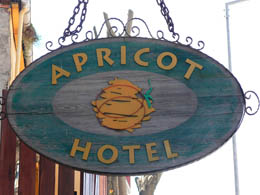
Our home in Istanbul
|
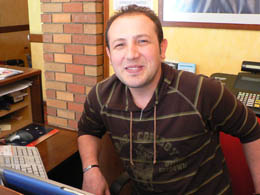
Mehmet, Our Turkish Guardian Angel |
After unpacking, we left the hotel on a mission -- to find an ATM and dinner. We walked past the Blue Mosque and Ayasofya, both lit up at night. We heard the call to prayer—strange, sad bellowing. I noticed the sky with a sliver of a moon and one star (actually Venus), which looked like the star and crescent on the Turkish flag shining down on the Blue Mosque. I was so taken by this site that I shared my awe with a carpet salesman on the street. He replied, “I’ve seen this for 32 years.”
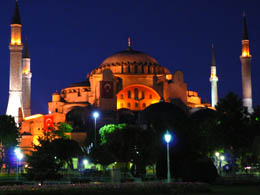
Ayasophia at Night |
After getting Turkish Lira from the ATM, we went to the Lale Restaurant (also called the Pudding Shop) because Bill remembered that it was listed in Frommer’s Guide. Unfortunately what Bill didn’t remember is that Frommer’s said it was “overrated.” The food was not very good and neither were the prices. It used to be a favorite of Hippies in the 1960’s. Our waiter seemed irritated with slow, jet-lagged brains trying to decide what to order. After our meal he insisted that we have pudding for dessert. We shared a rice pudding just so we’d get the check. Got back to our room at 9:30, to sleep by 10:30.
Saturday, April 21 - Istanbul
Our room was quiet (didn’t even hear the call to payer). Had a wonderful breakfast on the hotel terrace—lots of choices: eggs, cereal, cheeses, and that wonderful thick yogurt to die for when it’s covered with honey.
After breakfast we headed out to our first stop—The Blue Mosque. The Blue Mosque was surrounded by a beautiful park, full of tulips.
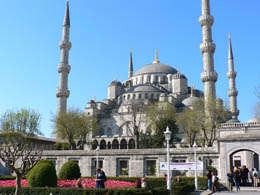
The Blue Mosque
|
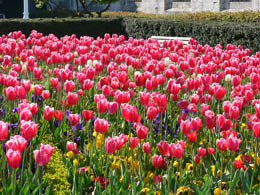
Beds of Tulips |
Tulips originated in Turkey, but were later claimed by the Dutch. We had never seen so many magnificent tulips. Istanbul was in the midst of a tulip festival and the whole city was draped in tulip glory.
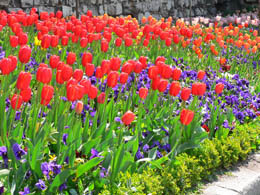
Tulips
|
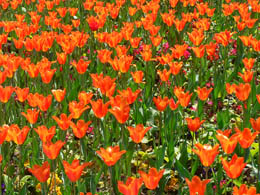
Knock my socks off Tulips |
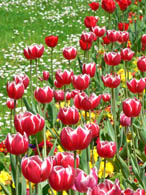
Tulips
|
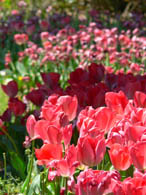
Can this be real?
|
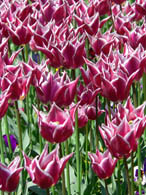 I Love Tulips! I Love Tulips! |
After oogling over the tulips, we entered The Blue Mosque. We had to remove our shoes and carry them in a recycled plastic bag. The Blue Mosque was built in the early 1600’s, by Sultan Ahmet I. The mosque is not blue. The name comes from the famous blue Iznik tiles on the walls inside. Sultan Ahmet I built the Blue Mosque to rival the Aya Sophia, just a stone’s throw across the street. With its six minarets outside, and huge columns, tiles and carpets inside, the Blue Mosque is indeed impressive.
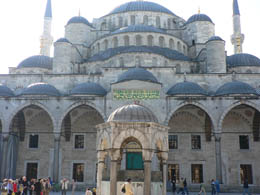
The Blue Mosque |
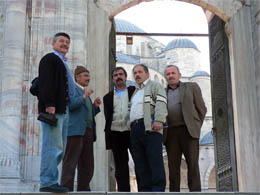
Hanging out at the Mosque |
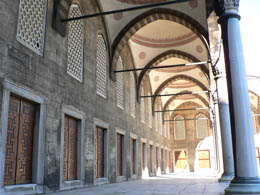
Columns and Arches |
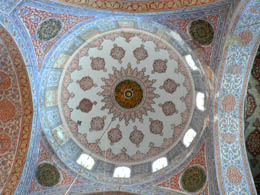
Ceiling Designs |
We walked through the Hippodrome. Now a calm city park, the Hippodrome was the heart of Constantinople's political and sporting life and the scene of games and riots through 500 years of Ottoman history as well. There is a 3500-year old obelisk there, brought to Constantinople in 390 A.D. During the Byzantine period, chariots (with 2 or 4 horses) raced here.
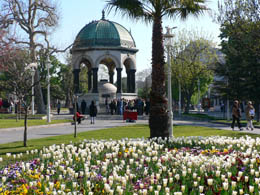
Hippodrome surrounded by a bed of tulips
|
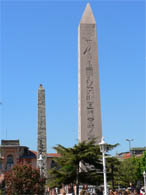
3500-year old Obelisk |
We walked to the Aya Sophia which means "church of the divine wisdom.” It’s one of the most important and impressive buildings ever constructed. Built in the 6th century, its wide dome was an engineering feat, which still amazes architects to this day. Every trick in the 6th century engineering book was used to obtain a huge dome unsupported by thick walls. It’s an amazing open space, with large marble columns, floor and wall panels. You could fly a kite in there. Originally built as a church, it was changed to a mosque and is now a museum. There are gorgeous mosaics which are currently being restored.
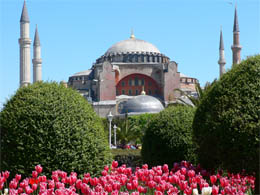
Ayasophia surrounded by a bed of tulips
|
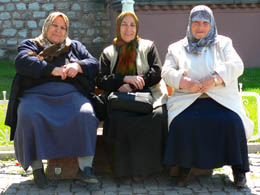
Hanging out |
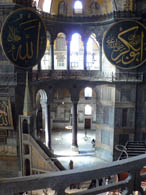
Ayasophia Interior
|
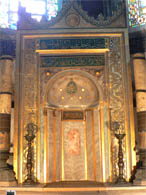 Niche facing toward Mecca
|
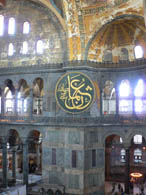 Ayasophia Interior
|
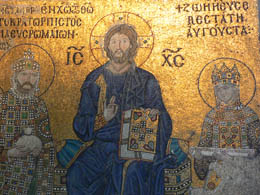
Mosaic (Jesus)
|
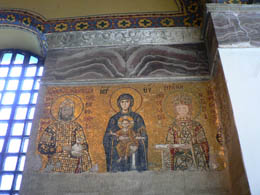
Mosaic (Mary) |
Our next stop was the Byzantine Sunken Palace Cistern, dating back to the 4th Century. A cistern is an underground room for holding water. This one is huge, measuring 140 by 70 meters, and holding 80,000 cubic meters of water (about 1200 shipping containers worth of water). The city's water supply is somewhere else now, so they drained this one and built a walkway around it. We meandered around the eerie, dark cavernous room, listening to the sound of dripping water. 336 columns line the walkway, two of which have Medusa-head bases, recycled from some other building simply for construction material.
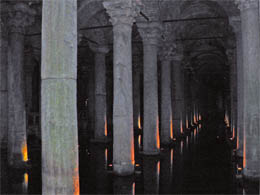
Sunken Palace Cistern
|
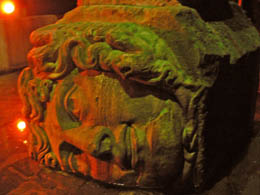
Medusa-head |
Walked to the Doy Doy Restaurant for a nice rooftop lunch, then headed for the Grand Bazaar. It was amazing, with lots of carpet shops, jewelry shops, clothes and junk. Prices seemed expensive, so we didn’t buy anything.
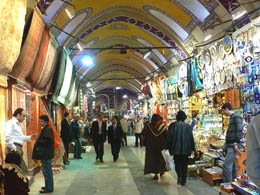
The Grand Bazaar
|
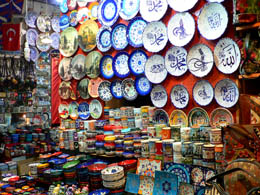
So many things to buy |
We walked to the Spice Market, stopping at the New Mosque along the way. (It’s not so new—completed in 1663; construction actually started before the Blue Mosque.) There were men washing their feet at a marble fountain, women with scarves and heavy coats, and men kneeling and praying to Mecca (lots of rapid bows—looked like good exercise.)
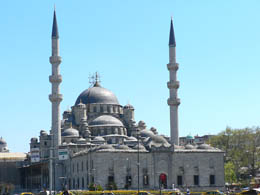
New Mosque |
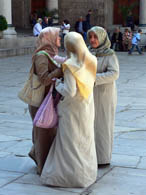
Women in the Courtyard of the New Mosque |
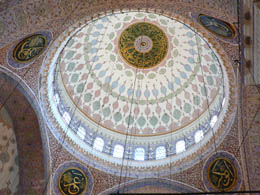
Heavenly Ceilings |
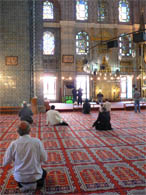
Praying towards Mecca |
The Spice Market was full of exotic sights, smells and sounds. The loud vendors would shout out something when they made a sale.
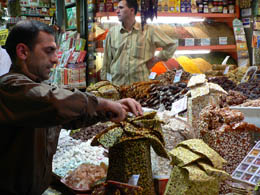
Spice Market |
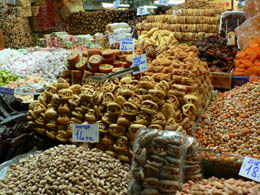
Spice Market |
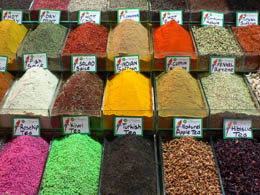
Spice Market |
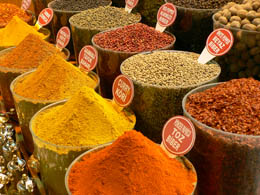
Spice Market |
We walked to the Golden Horn, across the Galata Bridge and up the hill to the Galata Tower. We wanted a beer before going into the tower, but had trouble finding a place that served beer (I guess it’s the Muslim ban on alcohol). Finally found a 16th century pub and ordered Efes beer (pretty good).
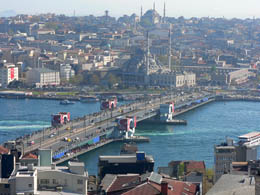
Galata Bridge
|
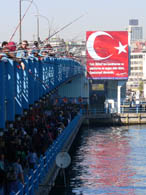
Fishing off Galata Bridge |
We climbed the Tower for views of the city, paying 8 lira ($6) each for the privilege. I told Bill it was worth it because the sun would be perfect for photos. I lied; we were there about an hour too early, so we paid our money, fought the crowds and looked into the glaring sun.
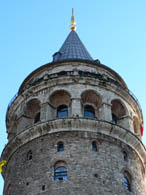
Galata Tower |
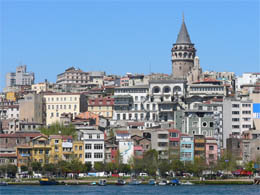
Galata Tower -- across the Golden Horn |
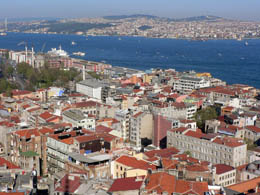
Views of the town from the Galata Tower |
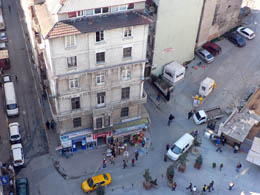
City Scenes from the Galata Tower |
We walked back to the Galata Bridge to catch the tram back to Sultanahmet and our hotel. We stopped at an ATM (the big city can suck up your funds very fast). Mehmet at the Apricot Hotel recommended the Rumeli restaurant for dinner (it’s also in Lonely Planet). We had an apricot, nut, orange salad, then a lamb dish and manti (ravioli covered in yogurt) – great choices for dinner!
Bill was fading from jet lag; rarely see him like this, so we headed back to our hotel by way of the Blue Mosque and Ayasofia, both lit up at night – Magical sights.
Sunday, April 22 - Istanbul
Nice breakfast at the Apricot—fresh squeezed orange juice, omelet, oatmeal, yogurt and honey, bread, and tea. Took off for our second day exploring Istanbul. Beautiful day. Tulips everywhere. We got to Topkapi Palace at 9:00, just as it opened and rented audio guides. They were very good.
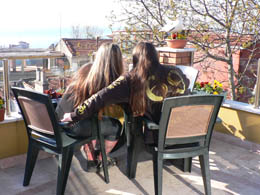
Breakfast on the Apricot's Rooftop |
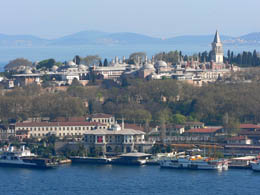 Topkapi Palace perched on a hill |
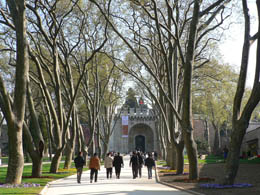
Entrance to the Palace |
Topkapi Palace was home of the Sultans for nearly 400 years, until one of the last Sultans built a new palace—Dolmabahce—on the Bosphorus. Topkapi was built by Mehmet the Conqueror on a hill overlooking the sea.
A highlight of the palace is the Harem, which has a separate admission charge and limits the number of people at any specific time. So we went to the Harem ticket booth and waited 20 minutes for it to open. The Harem was located so it could not be seen from the palace apartments or public areas. I was fascinated by the tales of Harem life:
- The head Eunuch was a Black African (castrated)
- Mirrors where installed at the entrance and exits to catch concubines trying to sneak out.
- The eunuchs arranged for Jewish merchants to bring their goods into the Harem so that the concubines could shop.
- The Harem was very elaborate because the first Sultan fell in love with and married one of the concubines.
- Concubines who bore a son for the Sultan got a room with a view.
- Educated concubines kept the books for the palace.
Because of the concern with hygiene, the Harem had 3 bathhouses. There was a special room just for the Sultan and his pals. Some of the rooms were elaborately decorated with blue tile walls, domed ceilings and Turkish fireplaces.
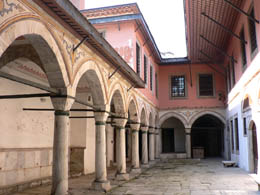
Harem |
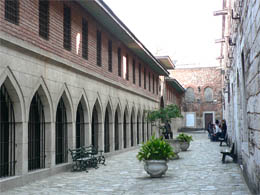
Harem |
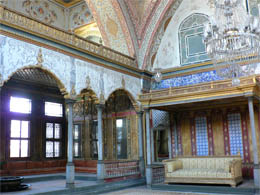
Harem –
Sultan Special Room |
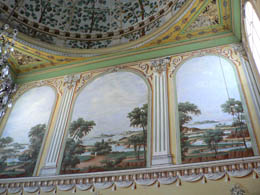
Harem Murals |
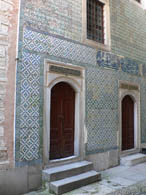
Harem |
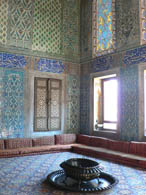
Harem – Interior
|
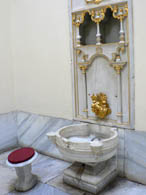
Harem Bathroom |
Next we visited the Treasury, which housed the spoils of war, gifts given to the Sultans and items purchased by the Sultans. There were lots of jewels—diamonds (including The Spoon Maker’s Diamond, the 5th largest diamond in the world, found by a peddler in the 17th century who sold it for pennies), emeralds, and rubies. The famous Topkapi Dagger is in the Treasury (subject of the 1964 film, Topkapi). There was an extensive porcelain exhibit, a golden throne, and lots of gold chalices and vases. The forearm of St. John the Baptist was there, along with a piece of his skull.
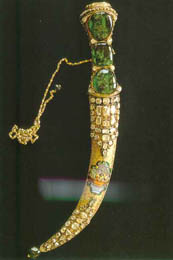
Topkapi Dagger |
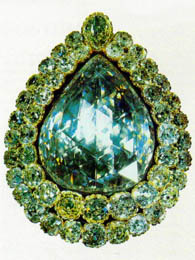
Spoon Maker's Diamond |
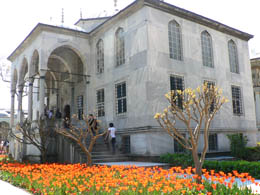
Treasury |
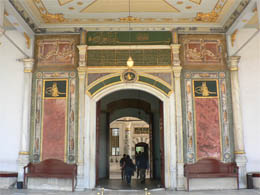
Entrance to the Treasury |
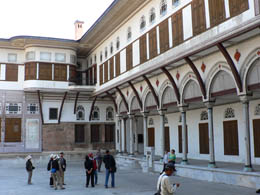
One of Many Palace Courtyards |
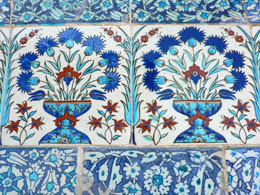
Tiled Palace Walls |
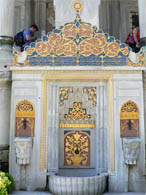
Fountain |
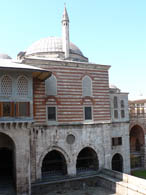
Palace |
Also housed in the Palace was a school for boys who passed a test—regardless of their income or class. The boys learned about government and had the opportunity to marry a concubine if they did well.
We walked out over a marble courtyard with a view of the city below. There used to be large celebrations here. The circumcision house is in the courtyard, where, you guessed it, they circumcised the Sultan’s many sons.
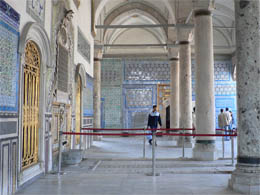 Open area next to the courtyard |
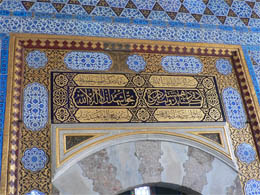
Decorative Doorways |
The gardens were filled with tulips. We didn’t want to leave without seeing Mohammed’s footprint and the staff of Moses, but this part of the palace was closed for renovation.

Palace Grounds with tulips everywhere |
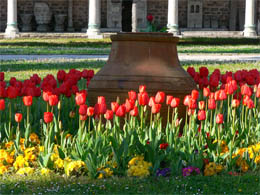
Palace Grounds |
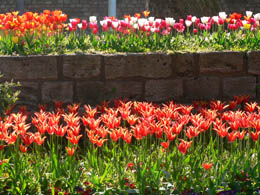
Palace Grounds |
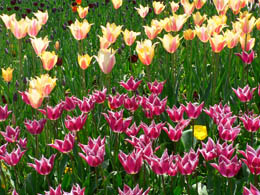
Tulips |
We had a sandwich at an outdoor restaurant just outside Topkapi’s gate. After lunch we went to the Archeology Museum, three huge buildings filled with interesting stuff:
- Walls from Babylon;
- Greek statues (better than anything we saw in Greece);
- Treaty written in 1200 on a stone tablet;
- Edicts from the Sultan written on stone;
- Lycian tombs;
- Early Bronze Age tools;
- Egyptian mummies and tombs.
At 4:30 our brains were full so we headed back to the Apricot. Stopped for a beer at an outdoor café on the way. (The waiter moved the water pipe off our table, saying, “This is not for your generation.” He later apologized for insulting us.)
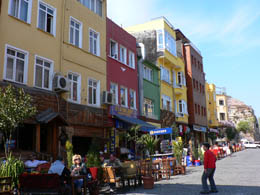 Nancy and Bill find an outdoor café for a beer |
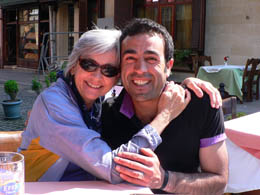
Nancy finds a hot Turkish guy at an outdoor café |
Back at the Apricot we checked our e-mail and conferred with Mehmet about the itinerary for the rest of our trip. We then headed for the Alburo restaurant where we had a nice dinner (lamb and chicken).
It was a long, wonderful day. Starting to get a little chilly.
Monday, April 23 – Istanbul
Today is Children’s Day, a national holiday in Turkey. We spent much of the morning with Mehmet planning the rest of our trip. At 11:00 we took the tram to Eminonu and then a taxi to the Kariye Museum (St. Savior in Chora) to see the famous mosaics. The church was converted to a mosque in the 16th century when they plastered over the beautiful frescoes and mosaics. The Byzantine mosaics, now mostly restored, provide a detailed account of early Christian history. The church was originally built in the 4th century as part of a monastery. The present structure dates from the 11th century.
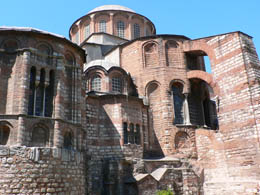
Kariye Museum (St. Savior in Chora) |
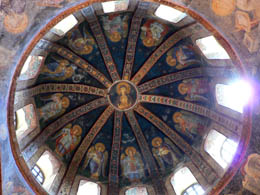
Dome Ceiling |
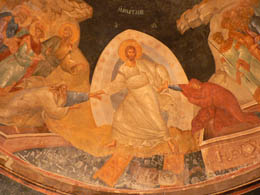
Fresco |
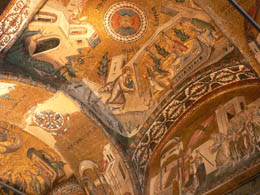
Fresco |
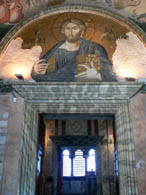
Mosaic |
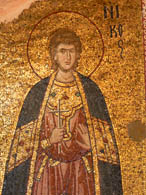
Mosaic |
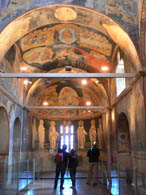
Kariye Museum – Arches |
We grabbed a taxi to take us back to the Galata Bridge to catch a ferry on the Bosphorus. The taxi driver ripped us off (probably had his meter set to the night rate), but, rather than make a fuss, we grudgingly paid to 20-lira fare (it should have been about 8) and told him we didn’t appreciate his dishonesty.
We got on the Tur Yol Ferry ($5 each) for a one and a half hour tour of the Bosphorus. A waiter offered us a lovely orange juice and pomegranate drink ($2 each). We found seats near a window, then two shifty-eyed, unshaven guys sat down next to us. One of the guys was carrying his jacket folded over his arm, “pick pocket” style. Alarm bells were going off in our heads. We were among the few non-Turks on the boat and figured we’d be prime targets. We clutched our stuff, glared at them and I even photographed them. We decided to move to another seat, next to two lovers. We kept our eye on the alleged pick pockets the whole trip. (They just sat quietly enjoying a nice cruise on the Bosphorus.) The Muslim women were very friendly and watched out for us. When a couple of rowdy teenagers stood at the window, blocking our view, one woman told them to leave, and they did. The same woman was worried that I’d get cold. I put my jacket on to make her feel better. A couple of Muslim women asked their English-speaking daughters to find out where we were from. They smiled when we said “California.” The day was clear, sky blue and windy. We saw interesting sites along the shore.
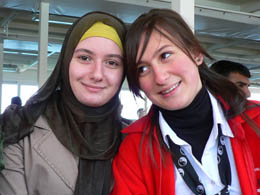
Two Turkish Girls on the ferry |
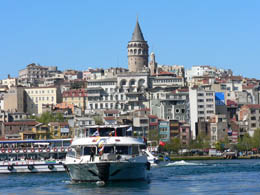
Scenes from the ferry ride (Galata Tower) |
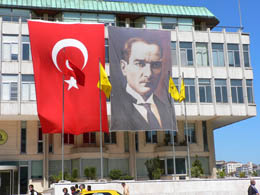
Proud of their flag and their great leader Ataturk |
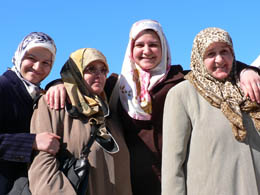
Having fun on the ferry ride |
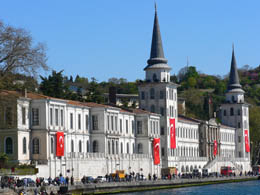 |
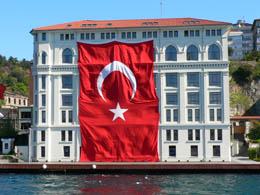 |
Scenes along the Bosphorus |
Scenes along the Bosphorus |
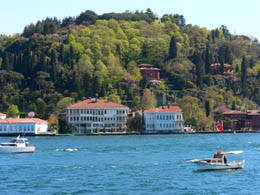
Scenes along the Bosphorus |
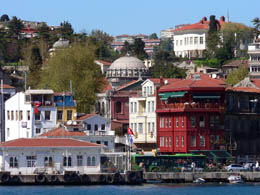
Scenes along the Bosphorus |
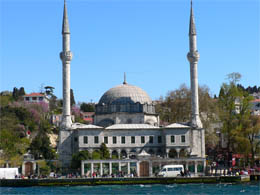
Little Mosque on the Bosphorus |
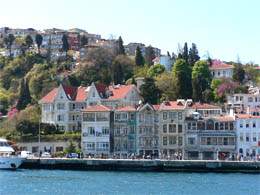
Little Town on the Bosphorus |
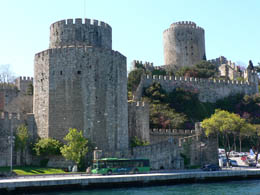
Little Castle on the Bosphorus |
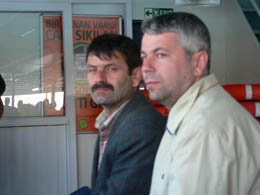
Suspects on the Bosphorus |
After the cruise we took the Tunel funicular and then walked 15-minutes up Istiklal Caddesi to Taksim Square. The street was loaded with people, vendors, ritzy shops and cafes (for a spot of Turkish tea and a game of backgammon). The scenes reminded me of Piccadilly Circus with lots of young, hip kids with multi-colored hair, tattoos and body piercings. I loved the mix of wild, wonderful fashions. However, we were disappointed in Taksim Square — a single statue of Ataturk in the midst of concrete and trolley tracks. We stopped for a beer on our way back—4 lira (about $3.00). Beer is expensive here.
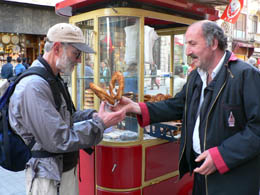
Afternoon snack from a Street Vendor |
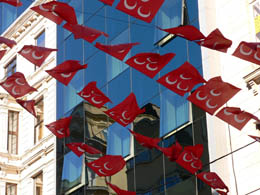
Flags Overhead – Lots of National Pride |
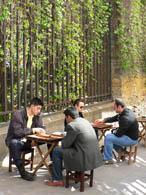
Tea and Backgammon |
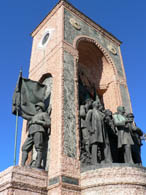
Statue of Ataturk in Taksim Square |
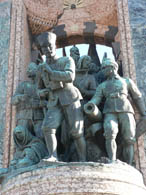
Statue of Ataturk in Taksim Square |
We picked out a restaurant in the Galata neighborhood. It was once a British prison. It was a challenge finding the place in the maze of streets, but we got help from several locals. We finally found the restaurant only to discovered that it was closed on Mondays -- so we took the tram back to Sultanahmet where we knew our way around. My only regret is that we didn't stroll one last time across the Galata Bridge—the sun was setting and the lighting on the New Mosque and Topkapi Palace was perfect. I watched it from the tram thinking of all the killer shots I missed. Back in the old town, we found a delicious little café—Karadeniz—recommended in Lonely Planet. A friendly guy lured us in thinking he had done his job, not knowing we were going there anyway. The guy came over several times while we were eating to tell Bill he was his life long friend. We had sausage and chicken kebops--fresh, good and cheap. It was quiet until a group of loud Australians came in. They were on their way, along with thousands of other Aussies and New Zealanders, to Gallipoli to commemorate the famous WWI battle in 1915. The Aussies were a nice group. Their guide still remembers the huge marguerita he had in San Diego – left an impression on him.
We returned to the Apricot for more travel planning with Mehmet. I checked the Internet while Bill discussed plans with Mehmet. Then a guy from San Francisco came in and engaged me in a Bush-bashing session – it’s easy to draw me in, even though I was tired and just wanted to go to bed.
Tuesday, April 24 – Istanbul to Selcuk
Awoke at 6:30, got to Apricot's terrace at 8:00, just as they started serving breakfast. Another beautiful day in Istanbul. The 4 gals serving breakfast wished us “bon voyage” and taught us how to say “thank you” in Turkish—“tea, sugar, a dream.”
We checked our email. Our strawberries back home are going crazy. Zion’s new cockatiel, Sweetie, adores Zi and squawks whenever she leaves the room. It was good to hear from home. We stopped at an ATM for more lira (it was crowded because the machines had just been re-filled after running out of money during the 3-day weekend).
We only had time for one museum this morning—the Museum of Islamic Arts on the Hippodrome, housed in the restored Palace of Ibrahim Pasha, built by Sultan Süleyman the Magnificent. The story of Ibrahim Pasha fascinated me. He was a young boy captured by the Sultan’s army in Egypt and brought to Istanbul (then called Constantinople). He became best friends with the Sultan’s son. When Süleyman the Magnificent became Sultan, he appointed Ibrahim as his top official and confidant. The Sultan built a magnificent palace for him, with the best view of the chariot races on the Hippodrome. The Sultan’s wife became jealous of her husband’s close relationship and convinced the Sultan to have his friend executed. As I walked through the museum, I imagined the two friends laughing, talking, plotting wars, sharing fears and secrets and then the horror of the friendship gone bad, poisoned by a jealous wife.
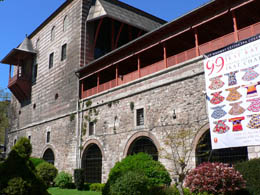 Museum of Islamic Arts |
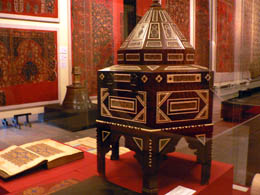
Ornate box to carry the Koran |
The exhibits were fascinating and filled in some more gaps of my fragmented understanding of this part of the world. We walked through room after room of treasures, including Turkish carpets, calligraphy, carved and inlaid wood, silverwork, glass, and porcelain. There is also a fully furnished nomads' tent and a 19th century Ottoman parlor.
We had an early afternoon flight to Izmir, so we headed back to the hotel to get our luggage and wait for the airport minivan, which the hotel had arranged and paid for. The minivan came on time, but there was a lot of traffic. When we got to the airport we had to go through security at the international terminal and then walk to the domestic terminal where we waited in another long line at the Onorair check-in counter. Once we were processed, we dashed to the gate and got there with only a couple of minutes to spare – a lot of stress for us Type-A personalities.
When we arrived at the Izmir airport we grabbed a taxi and asked to go to the bus station, so we could catch the bus to Selcuk. The taxi driver said the fare to the bus station was 50 lira ($37) and 75 lira ($55) to go all the way to Selcuk. We didn’t believe him (he spoke almost no English), so he called someone on his cell phone who spoke English. Bill talked to the person on the phone who confirmed that what the driver had told us was true. We decided to pay the 75 lira to take the taxi directly to our hotel in Selcuk. When we arrived at our hotel we asked if we had been ripped off. The owner of the hotel said that there is another bus station only 2 kilometers from the Izmir airport, and the taxi fare to that station would have only been a few lira, a fact that our taxi driver failed to mention. The 75 lira we had paid was the correct amount for a taxi from Izmir to Selcuk. Damn those weasels – you can’t win with cab drivers.
We settled into our room at the Hotel Bella. It was very small and we asked if a larger room was available. Erdal, the owner, said that they would move us to a larger room with a balcony tomorrow. Erdal invited us for apple tea on the top floor overlooking the town, St. John’s Basilica and the old castle. Then Erdal told us the heartbreaking story of the fire in January that destroyed the top floor restaurant, just after they completed a remodel of the hotel. They lost priceless antiques and carpets. But there was no evidence of the fire when we were there less than 3 months later.
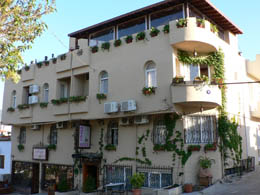
Hotel Bella, Selcuk |
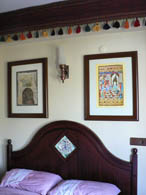
Our room at the Bella |
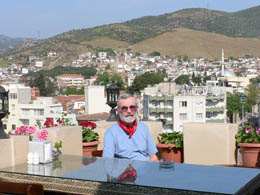
On the Terrace at the Bella |
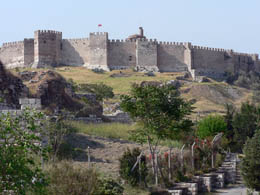
The Castle |
Bill and I shared an Efes beer (only 3 lira, about the lowest price we paid in Turkey), and some conversation with Tim a very nice guy from New Jersey traveling with his friend, George. We were also fascinated by the stork that nested on a pole (built by the hotel) right next to the hotel.
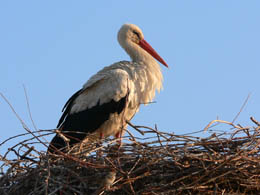 Stork Nesting |
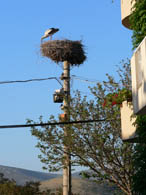
Stork Hotel |
We walked around Selcuk, passing several empty restaurants and shops. As we ignored one desperate carpet salesman, he said, “If you don’t come in, how can I rip you off?” I loved the crazy Turkish humor, including the shopkeeper who said, “I have everything in my store, except customers.”
We walked up the hill to the Isa Bey Mosque, built in 1375. It is unique because it has a courtyard.
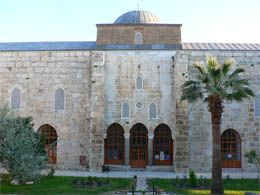
Isa Bey Mosque |
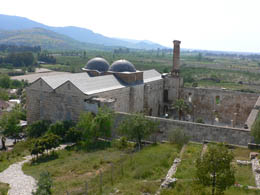
Isa Bey Mosque on the outskirts of Selcuk |
We walked through some residential neighborhoods where we saw kids playing soccer in the street, women doing needlework together and families hanging out on the dusty side streets. We covered the town in less than an hour.
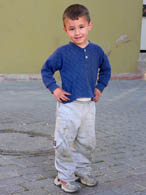
Friendly little guy |
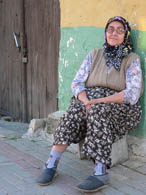
Cool Granny |
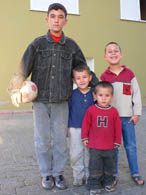
Future Soccer Players |
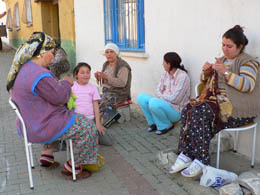
Busy with needlework |
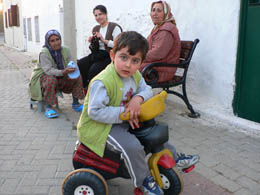
Handsome young Turk |
We saw a group of folks sitting in a courtyard, looking hopefully and desperately at their newly purchased and refurbished, but empty, pension called the Alihan or Outback. They wanted to know if we had the latest edition of Lonely Planet to see if their pension was listed in it. We didn’t have the latest edition -- it had just been published. Lonely Planet is powerful for those in the tourist industry – it can make you or break you.
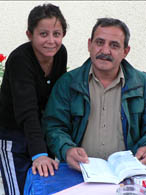 Hopeful new pension owners |
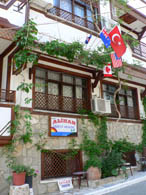
Outback, open and ready for customers |
We went back to the Hotel Bella for a nice huge five-course dinner (15 lira, $11), served under the open sky filled with storks looking for a place to roost. I counted 15 storks in the air at once. The cute, funny Turkish waiter made our dinner delightful. After the sun set, we moved next to the fireplace to have some tea and talk to some of the other hotel guests.
We retired to our room to study our guide books for our next adventure. | 










